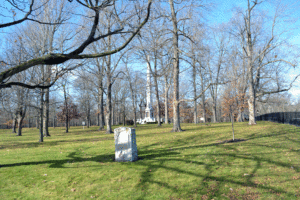Staff rides are a methodology to study campaigns and battles. The staff ride method consists of classroom instruction, a battlefield tour, and a final instruction period to synthesize classroom and field visit learning. Staff ride handbooks are developed as a resource for general military history study and to address specific points about a campaign and/or battle. The handbooks include research about the tactics, techniques, and procedures common to an era. In addition, they address teaching aspects unique to staff ride programs. For example, they include an investigation of factors that impact leader performance such as an individual’s education, personal experience, and military service.
In the classroom, traditional instructional methods are common. Nontraditional approaches are then applied to meet the unique objectives of staff rides and prepare for the field phase. For example, students are assigned a person to research and the student leads discussions about their subject’s campaign/battlefield decision-making during the field phase.
The field phase consists of visits to the locations (called “stands”) where critical activities occurred. Staff rides include numerous stands (the field phase of some staff rides can take more than one day to complete). Once at a stand, a staff ride team member introduces the stand and places it in context of the campaign or battle. A discussion occurs at each stand and as part of the discussion, students will describe the specific battlefield activities, the influence of military factors (e.g., terrain), as well as key decisions and the leaders who made them. The discussions about leaders incorporate substantial context. The relevant elements of the biographical sketches developed by students during the classroom phase are discussed at the stands.
The synthesis session is usually a short period to conclude the staff ride. During this phase students discuss what they learned as a result of the staff ride program. This period of instruction is moderated by the staff ride team in order to keep things on track. However, the bulk of the discussion is student led.
Context is a major part of any staff ride program. If students do not understand the military, political, and social context, they will not understand why critical activities occurred. For example, context for the Battle of Tippecanoe includes the fact that after the Revolutionary War, the British continued to meddle in the affairs of the nascent American Republic. The British maintained commercial and political interests in North America and worked with several Indian tribes in pursuit of their objectives. Tension between British interests and American sovereignty continued for many years. These factors ultimately led to the the Battle of Tippecanoe. Without this context it is difficult for students to understand American expansion and Indian confederacy efforts–enabled by the British–to counter this expansion.
For more information about staff rides see: the staff ride handbook, 2015 staff ride workshop conducted for the Tippecanoe County Historical Association, and a presentation about creating the staff ride for the Battle or Tippecanoe.



